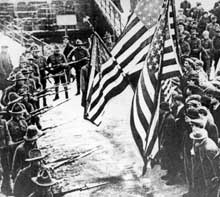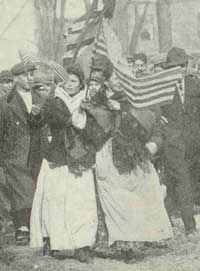1912 Textile Strike Put Women in the Line of Fire
February 29, 2008
(This "Look Back" feature first appeared in the March/April 2008 issue of The American Postal Work Magazine.)
Early in the 20th Century, fully half of the 80,000 people living in Lawrence, MA, labored in its textile industry.
The typical workplace was dimly lit, dangerously cramped with machinery, cold in the winter, and hot in the summer. Most of the workers were female immigrants younger than 18. In the factory, they were subject to all manner of ethnic slurs and sexual harassment.
Perhaps worst of all, the dirty and crowded mills were breeding grounds for tuberculosis. Elizabeth Shapleigh, a Lawrence physician, estimated that a third of the workers in the mills would die before they reached age 25.
The rewards were limited. Working as much as 60 hours a week, employees of American Woolen Goods, a conglomerate of three dozen mills in the area, earned less than $9 a week, and children as young as 14, the minimum legal age, went to work in the mills.
Strike!
On Jan. 1, 1912, a state law took effect that reduced the maximum workweek from 56 hours to 54. Ten days later, when Lawrence’s textile workers opened their pay envelopes, most were dismayed to find what some had predicted: Their wages had been cut to reflect the shorter workweek, a 30-cent difference in take-home pay that would have paid for several loaves of bread. 
Polish weavers at Everett Cotton Mills were the first to shut down their looms. They walked off the job and marched through the city’s streets, shouting, “Short pay! Short pay!” Soon they were joined by 30,000 workers from the other mills, mostly women, chanting similar slogans in accented English, and in Polish, French, Italian, and other languages.
While the United Textile Workers, an AFL affiliate that represented mostly white, English-speaking skilled craftsmen, did little, a strike committee was quickly formed with the help of the Industrial Workers of the World, which had been active in the community for several years.
To keep the workers from being divided along ethnic lines, the IWW committee, led by Joseph Ettor, Arturo Giovannitti, and Elizabeth Gurley Flynn, recruited factory representatives from every background.
The workers came up with a simple list of demands: a 15 percent increase in wages, double pay for overtime work, and a promise of no retaliation against strikers.
Expecting resistance from the factory owners, the strikers formed relief committees to provide food and medical care to families left with no income. Meanwhile, the IWW raised funds for the strikers in New York and other major cities, as well as from IWW members in the textile workers’ native lands.
Taking to the streets by the thousands, large groups of protesters would visit the city’s stores, then leave without buying anything. This effectively disrupted businesses and demonstrated the importance of the strikers to the city’s economy. During the daily marches, banner-carrying workers added singing, a novelty at the time.
A banner proclaiming, “We want bread, and roses too,” signified that the strikers demanded respect not just as workers, but as women.
Backlash
No New England town had ever seen labor protests on the scale of “The Bread and Roses Strike,” and the organizers correctly predicted that factory owners and municipal officials would react harshly.
To repress the workers, Lawrence’s mayor ordered local militia to patrol the streets, and in the dead of winter factory-owned fire hoses were sprayed on picketers gathered near the mills. When workers responded by throwing ice, breaking some windows, three dozen strikers were arrested. The governor of Massachusetts sent state police and militia to Lawrence.
 Encouraged by Flynn, the feminist firebrand, women showed they wouldn’t be intimidated: They led the pickets and faced down the police and company thugs. After a fire- hose drenching, a group of women cornered a police officer on a bridge, stripped off his clothes and tossed him into the icy river below.
Encouraged by Flynn, the feminist firebrand, women showed they wouldn’t be intimidated: They led the pickets and faced down the police and company thugs. After a fire- hose drenching, a group of women cornered a police officer on a bridge, stripped off his clothes and tossed him into the icy river below.
“One policeman can handle 10 men,” District Attorney Harry Atwell lamented, “while it takes 10 policemen to handle one woman.” The women strikers were full of “lots of cunning and also lots of bad temper,” a stunned boss complained.
In an attempt to portray strikers as anarchists, William Wood, the owner of the American Woolen Company, hired John Breen, a local undertaker and school board member to plant dynamite in several locations. The move backfired when the IWW obtained evidence that newspaper articles about the dynamite had been printed before the dynamite was “discovered.” (Breen eventually confessed and was released from jail after paying a fine. Wood was never charged.)
As press coverage spread, the factory owners and authorities feared that the assertive Bread and Roses women were gaining sympathy in the community and across the nation. In an effort to discredit the unionists, the company hired strikebreakers to infiltrate the picket lines.
The union was aware that company spies would try to cause trouble and, on Jan. 29,more than two weeks into the strike, Ettor urged the workers to remain peaceful as they readied for their largest demonstrations yet. That evening, police cornered a group of marchers. Packed tightly together, some apparently pushed back, and the police advanced with their clubs. A shot rang out and, when the melee was over, Annie LoPizzo, a 34 year-old striker, was dead.
Witnesses claimed that the bullet was fired by a police officer, Oscar Benoit, but he and others insisted the shot was fired from behind them, by someone specifically targeting LoPizzo. IWW leaders Ettor and Giovannitti were arrested, even though they were at a union meting miles away when the shooting occurred. The two were charged with provoking the violence and being “accessories to the murder.” (They were held in jail for eight months before being acquitted at trial.)
City officials used the shooting as justification for declaring martial law and banned all public meetings. But the picketing continued, with striking families receiving $2 to $5 a week through donations from supporters around the country. “Relief was so efficiently handled,” wrote labor historian Samuel Yellin, “that during the 10-week strike there was no wavering whatsoever in the strikers’ ranks.”
Turning Point
As the strike dragged on, the textile companies remained steadfast in their refusal to negotiate. To help the strikers, the IWW arranged for several hundred children to live with supporters in New York City while their mothers walked the picket lines. Then, in an incident that sparked nationwide outrage six weeks into the strike, city officials intercepted 100 children bound for Philadelphia. Police and state militia gathered at a railroad station, and were photographed clubbing women and children.
The press likely had been alerted by the IWW, and news stories prompted even more support for the strikers. Congress held hearings, with young women describing the deplorable conditions at the Lawrence factories, including having to pay for drinking water and perform unpaid work on Saturdays.
The national publicity helped break the employers’ resolve. On March 1, they offered a 5 percent wage increase, which the workers rejected, and on March 12, the American Woolen Company agreed to all the strikers’ demands. By the end of the month, the other factories in Lawrence followed suit, and, eager to avoid similar confrontations, many other New England factories raised workers’ pay and shortened their workweek.
The 1912 “Bread and Roses” strike is remembered as the first major labor protest lead by women, and as one where workers overcame ethnic differences. It set the stage for gains in the struggles against child labor, subsistence-only wages, workplace safety, and the right to organize – important markers in labor’s long fight for justice.
A festival commemorating the Bread and Roses strike is held every Labor Day at Lawrence Heritage State Park. Visit www.breadandroses.net for more information.



